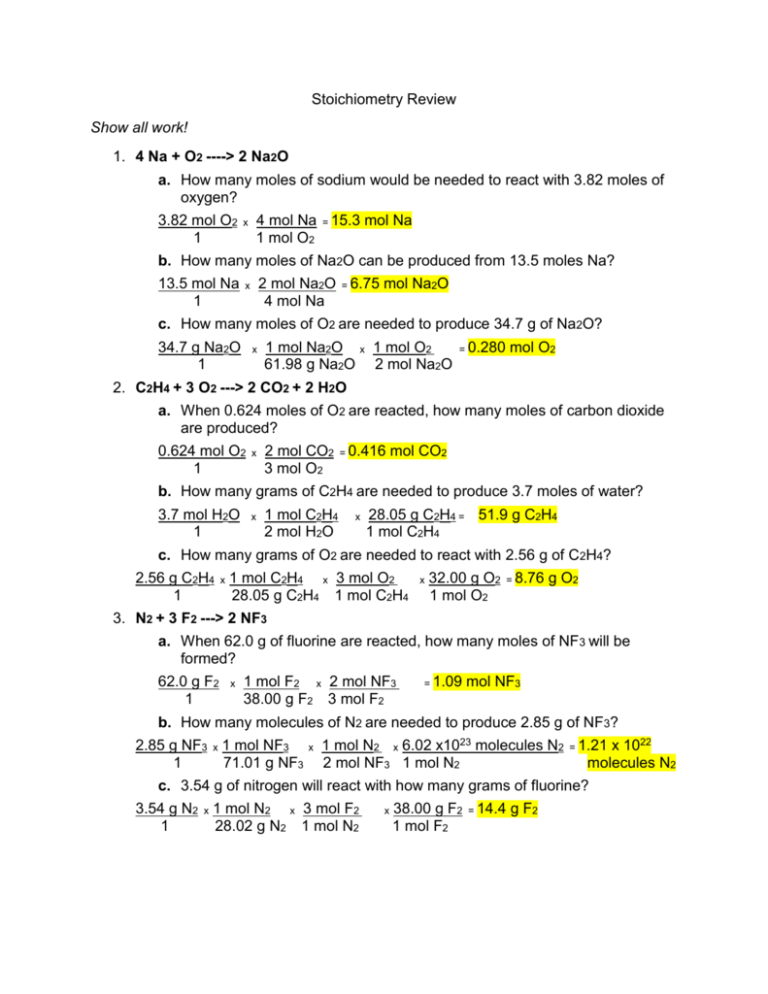Stoichiometry Review
advertisement

Stoichiometry Review Show all work! 1. 4 Na + O2 ----> 2 Na2O a. How many moles of sodium would be needed to react with 3.82 moles of oxygen? 3.82 mol O2 1 x 4 mol Na = 15.3 mol Na 1 mol O2 b. How many moles of Na2O can be produced from 13.5 moles Na? 13.5 mol Na 1 2 mol Na2O = 6.75 mol Na2O 4 mol Na x c. How many moles of O2 are needed to produce 34.7 g of Na2O? 34.7 g Na2O 1 x 1 mol Na2O x 1 mol O2 61.98 g Na2O 2 mol Na2O = 0.280 mol O2 2. C2H4 + 3 O2 ---> 2 CO2 + 2 H2O a. When 0.624 moles of O2 are reacted, how many moles of carbon dioxide are produced? 0.624 mol O2 1 x 2 mol CO2 = 0.416 mol CO2 3 mol O2 b. How many grams of C2H4 are needed to produce 3.7 moles of water? 3.7 mol H2O 1 x 1 mol C2H4 2 mol H2O x 28.05 g C2H4 = 51.9 g C2H4 1 mol C2H4 c. How many grams of O2 are needed to react with 2.56 g of C2H4? 2.56 g C2H4 x 1 mol C2H4 x 3 mol O2 1 28.05 g C2H4 1 mol C2H4 x 32.00 g O2 = 8.76 g O2 1 mol O2 3. N2 + 3 F2 ---> 2 NF3 a. When 62.0 g of fluorine are reacted, how many moles of NF3 will be formed? 62.0 g F2 1 x 1 mol F2 x 2 mol NF3 38.00 g F2 3 mol F2 = 1.09 mol NF3 b. How many molecules of N2 are needed to produce 2.85 g of NF3? 2.85 g NF3 x 1 mol NF3 1 71.01 g NF3 x 1 mol N2 x 6.02 x1023 molecules N2 = 1.21 x 1022 2 mol NF3 1 mol N2 molecules N2 c. 3.54 g of nitrogen will react with how many grams of fluorine? 3.54 g N2 x 1 mol N2 x 3 mol F2 1 28.02 g N2 1 mol N2 x 38.00 g F2 = 14.4 g F2 1 mol F2 4. 4 NH3 + 7 O2 ---> 4 NO2 + 6 H2O a. What mass of NO2 can be produced from 3.56 x 1022 molecules of oxygen? 3.56 x 1022 molecules O2 x 1 mol O2 1 6.02 x 1023 molecules O2 x 4 mol NO2 7 mol O2 x 46.01 g NO2 = 1 mol NO2 1.55 g NO2 b. 13.8 g of NH3 would be able to produce how many moles of H2O? 13.8 g NH3 1 1 mol NH3 x 6 mol H2O 17.03 g NH3 4 mol NH3 x = 1.22 mol H2O c. How many grams of O2 are needed to produce 15.5 g of H2O? 15.5 g H2O x 1 mol H2O 1 18.02 g H2O x 7 mol O2 6 mol H2O x 32.00 g O2 = 32.1 g O2 1 mol O2 5. 2 Al + 6 HCl ----> 3 H2 + 2 AlCl3 a. If you start with 5 L of 1.5 M HCl and you make 1.98 g of H2. What is your % yield? 1.5 M HCl = x / 5 L 7.5 mol HCl 1 x x = 7.5 mol HCl 3 mol H2 6 mol HCl x 2.02 g H2 = 7.575 g H2 1 mol H2 (1.98 g H2 / 7.575 g H2) x 100% = 26.1% b. Suppose your % yield was 88.3% instead, how much H2 would you make? (x/ 7.575 g H2) x 100% = 88.3% x = 6.69 g H2 6. 2 Fe2S3 + 3 C ----> 4 Fe + 3 CS2 a. How many grams of iron can be made from 119 g of Fe2S3 and 12.7 g C? 119 g Fe2S3 x 1 mol Fe2S3 x 4 mol Fe 1 207.88 g Fe2S3 2 mol Fe2S3 12.7 g C x 1 mol C x 4 mol Fe 1 12.01 g C 3 mol C x x 55.85 g Fe 1 mol Fe 55.85 g Fe 1 mol Fe = = 63.9 g Fe 78.7 g Fe 63.9 g Fe b. What is the limiting reagent? Fe2S3 c. After the above reaction, you produce 35.6 g of Fe. What is your % yield? (35.6 g Fe / 63.9 g Fe) x 100% = 55.7% 7. 6 CO2 + 6 H2O ----> C6H12O6 + 6 O2 a. How many grams of sugar can be made from 50.0 g of CO2 and 50.0 g of water? 50.0 g CO2 x 1 mol CO2 x 1 mol C6H12O6 1 44.01 g CO2 6 mol CO2 50.0 g H2O x 1 mol H2O 1 18.02 g H2O x x 1 mol C6H12O6 6 mol H2O x 180.16 g C6H12O6 1 mol C6H12O6 180.16 g C6H12O6 1 mol C6H12O6 = = 34.1 g C6H12O6 83.3 g C6H12O6 34.1 g C6H12O6 b. What is the limiting reagent? CO2 c. What is the excess reagent? H2O d. How many grams of the excess reagent are leftover? 50.0 g CO2 x 1 mol CO2 x 6 mol H2O 1 44.01 g CO2 6 mol CO2 x 18.02 g H2O 1 mol H2O 50.0 g H2O - 20.47261986 g H2O = 29.5 g H2O = 20.47261986 g H2O







